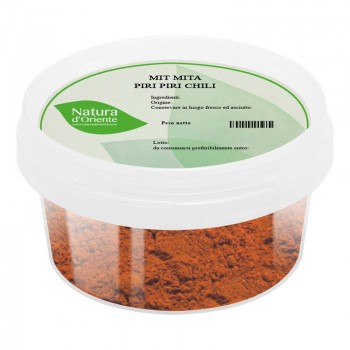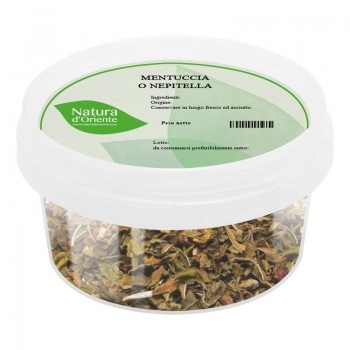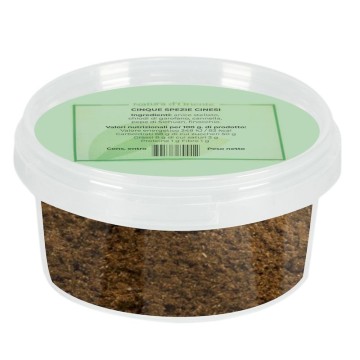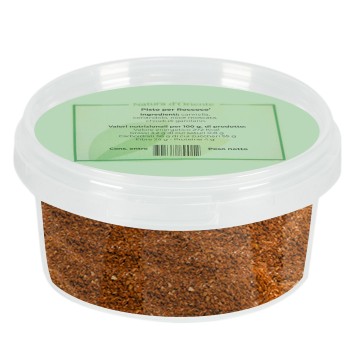This curry powder combines ground spices and herbs into a uniquely flavorful seasoning. It is made up of ingredients that complement each other, combining many of the complex flavors of Thai cuisine, including dried chili peppers, ginger, and lemongrass. The chili peppers give red curry its name. Other exotic spices include cumin, coriander, and turmeric. Thai red curry blend is a popular choice for enhancing Thai and Asian dishes, as well as many European cuisines that benefit from its spicy flavor. The flavor profile of this curry is a complex balance of spicy heat, sweetness, saltiness, and a hint of bitterness. It gives dishes a medium heat level, given the presence of chili peppers and paprika used in the blend, balanced with less pungent spices. A choice to avoid excessive spiciness and give dishes a more balanced and intense dimension.
In addition to its exotic and special flavor, this Thai red curry can provide nutritional benefits. The ingredients are rich in beneficial nutrients, containing antioxidants and vitamins. In particular, chili pepper is rich in potassium, copper and beta-carotene, while other ingredients provide nutrients such as iron and calcium (turmeric, fenugreek and cumin). The capsaicin contained in chili peppers can also stimulate metabolism and reduce appetite, for those who want to include this spice mix in their diet. At a digestive level, curry is useful for its qualities that promote the transit of food in the gastrointestinal tract, avoiding the formation of excess gas. Lemongrass, chili pepper and garlic, together with other spices, contribute to the well-being of the cardiovascular system and proper blood circulation. It is also useful to use red curry on the table to add flavour, avoiding salt and following a low-sodium diet.
Thai Red Curry Spices
The blend combines 10 spices and aromatic herbs, creating nuances of particular aromas and flavours.
The turmeric imparts a pungent heat in a light way, with bitter and deep notes; it gives an intense and exotic aroma, easily recognisable in the blend.
The fenugreek gives the blend a spicy and slightly bitter flavour. The aroma recalls fresh hay, with an aftertaste that evokes celery.
The chili pepper introduces the most intense spicy flavour, stimulating the palate with a provocative and energetic heat effect.
The pepper arouses a deep, acrid and spicy note on the palate, but not excessively; The strong, pungent aroma is a fundamental element of the spice blend.
The ginger provides a warm, pungent flavor with a sweetish touch, which pairs well with the lemongrass and cumin. An earthy aftertaste clashes with fresh notes, in balance.
The coriander infuses notes reminiscent of citrus, dill and fennel. The sweet, fresh aroma and taste pair well with the cumin.
The lemongrass evokes the aroma and fresh taste of lemon, with a sour, pungent aftertaste. The flavor is intensified with delicate, perfumed notes reminiscent of roses.
The mustard gives the blend its characteristic flavor between spicy and sweet; the pungent aroma evokes anise and reinforces other tantalizing elements.
Cumin inspires a pungent yet delicate taste on the palate, pairing with turmeric; its warm and slightly sweet aroma can give off toasty notes.
Paprika adds a spicy, smoky flavor, with some much-appreciated bitter notes to create an intoxicating depth to the curry.
Using Thai Red Curry in Cooking
The ground version makes Thai curry convenient in the kitchen, to include the powdered spices in all recipes, already mixed and ready to use. This red curry powder is versatile, providing a medium heat, with citrus notes of lemongrass; it adds a touch of deep flavor, complete with pungent, sweet, sour and a hint of bitterness. For its balance, you can use this blend when the recipe calls for curry powder that is not too spicy.
The spice blend is delicious when combined with coconut milk as in the Asian tradition. You can mix and briefly fry the red curry in oil, to enhance the flavors and better incorporate the powder into the coconut milk (or other elements). Alternatively, you can use the curry as a seasoning to sprinkle at the end of cooking.
Meat and fish: excellent sprinkled on grilled meat and fish, stews, chicken, sausages, seafood and fish dishes such as poached salmon or cod in curry sauce, and red curry prawns. In particular, it is used as a base for Thai dishes such as Kaeng Phet, where the curry powder is mixed with coconut milk and prawn paste. This combination gives the dish a spicy, tangy and intense flavour.
Savory recipes: This seasoning can be added to rice, vegetables, Thai red curry noodles and fish cakes. It adds depth and flavour to many legume dishes, potatoes, and brightens up soups. Try it on eggs or in yogurt for a complex flavour. To make a savory Thai curry dish, fry 4 tablespoons of the paste in coconut milk cream, add meat and toasted peanuts (or peanut butter), then stir in your favourite vegetables.
Baking: Thai red curry powder can also be used to infuse its flavour into bread toppings, crackers and other specialities.
Sauces: You can use the powder to make sauces for meat and fish, and in the classic Thai curry paste recipe - mixing the spices with water, fish sauce or shrimp. This paste is traditionally mixed with coconut milk, the fat of which helps to take the heat out of the paste. This finely ground powder is flexible to use to mix with butter and brush on fish before grilling.
Its dark red pigment also makes dishes bright if you want a colorful finish - just the tip of a teaspoon is enough.
Thai Red Curry Chicken Legs
Ingredients: 1 kg boneless, skinless chicken legs - ¼ cup chopped basil leaves - 2 green onions, thinly sliced - ¼ cup fish sauce - 3 tablespoons olive oil (or canola oil) - 2 tablespoons freshly squeezed lime juice - 1 tablespoon lime zest - 1 tablespoon dark brown sugar - 2 teaspoons ground Thai red curry - ½ teaspoon salt - ½ teaspoon freshly ground black pepper.
Directions
In a medium bowl, combine the basil, green onions, fish sauce, 2 tablespoons olive oil olive oil, lime juice, lime zest, brown sugar, Thai red curry, salt, and pepper. Combine chicken and spice mixture in a clear bag; marinate for at least 2 hours, turning bag occasionally. Drain chicken from marinade. Preheat grill to medium-high heat. Brush chicken with remaining tablespoon olive oil; season with salt and pepper to taste. Add chicken to grill and cook, turning occasionally, until chicken is cooked through, reaching an internal temperature of 165 degrees, about 10 minutes. Serve hot, with rice and vegetables, if desired.
Origins and History of Thai Red Curry
Red curry powder originated in Thailand and Southeast Asia, where it is commonly used in soups and stir-fries. Red curry powder is often made into a paste, before cooking, using a liquid of your choice. Its history dates back to our Middle Ages, around the 4th century, when Indian merchants began trading spices with Buddhist missionaries in the territory. This interaction paved the way for the evolution of curry recipes in Thailand. Recently, there has been a cultural and governmental push for the labeling of red, green and yellow Thai curries – which has helped popularize Thai food around the world. In addition to its use in cooking, this ground curry is also present in popular culture as a natural remedy for cold symptoms and intestinal disorders. In addition to this red curry, due to the red chili peppers used in its preparation, yellow curry gets its name from the bright color of turmeric. Both contain elements common to Thai cuisine such as ginger, lemongrass, garlic and cumin. The word “curry” that we use, was actually introduced by the British in relation to Indian cuisine – experimented with during the colonial period. It refers to the mixture of spices, always different in its composition depending on the regional recipes. In reality, it derives from the typical local dishes created with the spicy sauce “kari” (curry). From this name, the Thai ground spices are also defined.



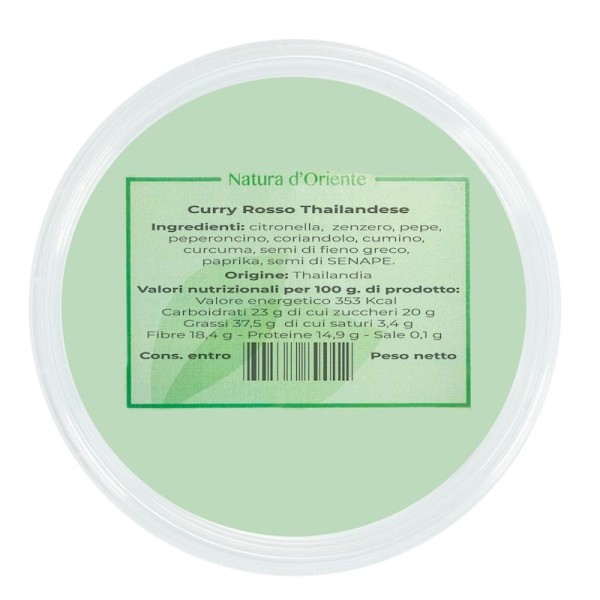







 No reward points for this product.
No reward points for this product.



